towing Citroen JUMPY 2016 2.G Owner's Manual
[x] Cancel search | Manufacturer: CITROEN, Model Year: 2016, Model line: JUMPY, Model: Citroen JUMPY 2016 2.GPages: 595, PDF Size: 12.47 MB
Page 5 of 595

.
.
Jumpy _en_Chap00a_sommaire_ed01-2016
Driving recommendations 196
Starting-switching off the engine, manual key, remote control
1
99
Starting and switching off the engine, "Keyless Entry and Starting"
2
02
Parking brake
2
05
Hill start assist
2
06
5 -speed manual gearbox
2
07
6 -speed manual gearbox
2
07
Gear shift indicator
2
08
Automatic gearbox
2
09
Electronic gearbox
2
14
Stop & Start
2
18
Head-up display
2
22
Memorising speeds
2
24
Speed limit recognition
2
25
Speed limiter
2
29
Cruise control
2
32
Dynamic cruise control
2
36
Collision Risk Alert and Active Safety Brake
2
43
Lane departure warning system
2
48
Fatigue detection system
2
50
Blind spot monitoring system
2
52
Parking sensors
2
55
Reversing camera, interior mirror
2
58
180° rear vision
2
59
Under-inflation detection
2
62Fuel tank
2 65
Diesel misfuel prevention 26
6
Snow chains
2
68
Towing a trailer
2
69
Energy economy mode
2
70
Accessories
2
71
Roof bars / Roof rack
2
73
Changing a wiper blade
2
74
Bonnet
2
76
Diesel engine
2
77
Checking levels
2
78
Checks
2
81
AdBlue
® and SCR system
(BlueHDi Diesel) 2 83
Warning triangle (stowing)
2
87
Tool box
2
87
Temporary puncture repair kit
2
90
Changing a wheel
2
96
Changing a bulb
3
03
Changing a fuse
3
16
12 V battery
3
21
Towing
325
R
unning out of fuel (Diesel)
3
27Dimensions
3
28
Engines
3
32
Weights
3
32
Identification markings
3
37
Driving
Practical information
In the event of a breakdown Technical data
Emergency or assistance 3
38
CITROËN Connect Nav 3 41
CITROËN Connect Radio
4
29
Bluetooth
® audio system 4 83
Audio and telematics
Alphabetical index
Contents
Page 6 of 595

4
Jumpy _en_Chap00b_vue-ensemble_ed01-2016
Exterior
Filler cap, fuel tank 265 -266
Misfuel prevention 26 6-267
Running out of Diesel fuel, priming
3
27
Under-inflation detection
26
2-264
Tyres, pressures
2
63 -264, 337
ESC programme
1
61-163
ABS, EBFD
1
62
DSC, ASR
1
63
Grip control
1
63, 164-165
Snow chains
2
68
Front doors
7
4-75
AdBlue
® tank 28 3-286
Tool box 2 87-289
Automatic illumination
of headlamps
1
49
Automatic headlamp dipping
1
53 -154
Direction indicators
1
48
Manually adjusting the headlamp
beam height
1
55
Changing front bulbs
3
03 -309
Headlamp wash
1
58
Opening the bonnet
2
76 Key
47
K
ey, remote control
4
7-54
Changing the battery, reinitialisation
5
4
Keyless Entry and Starting
5
5-71
Changing the battery, reinitialisation
7
0
Starting - switching off the engine, key, remote control
1
99 -201
Starting - switching off the engine, Keyless Entry and starting
2
02-204
Locking / unlocking from inside
7
2-73
Alarm
9
5-97
Speed limit recognition
2
25 -228
Collision Risk Alert
2
43 -245
Active Safety Brake
2
43, 246 -248
Fatigue detection
2
50-251
Changing a wiper blade
2
74
Automatic wiping
1
57-158
Front demisting, defrosting
1
32
Front foglamps
1
47, 309
Daytime running lamps
1
49, 305
Cornering lighting
1
52
Parking sensors
2
55 -257
Towing
325
-326
Over view
Page 7 of 595

5
Jumpy _en_Chap00b_vue-ensemble_ed01-2016
Number plate lamp 311, 314
- s ide-hinged doors
-
t
ailgate
Reversing camera
2
58
180º Rear vision
2
59 -261
Changing rear bulbs
3
10, 315
Rear lamps (side-hinged doors)
3
03, 310 -312
Rear lamps (tailgate)
3
03, 313 -315
3
rd brake lamp 3 11, 314
-
s ide-hinged doors
-
t
ailgate
Warning triangle
2
87
Temporary puncture repair kit
2
90 -295
Spare wheel, jack, changing a wheel
2
96-302
Inflation, pressures
2
95, 337Door mirrors
1
43 -144
-
manual
-
electric
Demisting-defrosting the mirrors
1
33
Blind spot monitoring system
2
52-254
Fixed crew cab
1
17-118
Manual sliding side door(s)
7
5 -77, 84- 86
Electric sliding side door(s)
7
8 - 83, 84- 86
Hands-free sliding side door(s)
87
-90
Manual child lock
1
94
Electric child lock
1
94
Rear window child lock
1
95
Direction indicator side repeaters
3
05
Accessories
2
71-273
Roof bars / Roof rack
2
73
Towing
325
-326
Trailer towbar
1
98, 269
Rear parking sensors
2
55 -257
Side-hinged doors
9
1-93
Tailgate
9
4
Demisting-defrosting
the rear screen
1
34
Exterior (continued)
.
Over view
Page 120 of 595
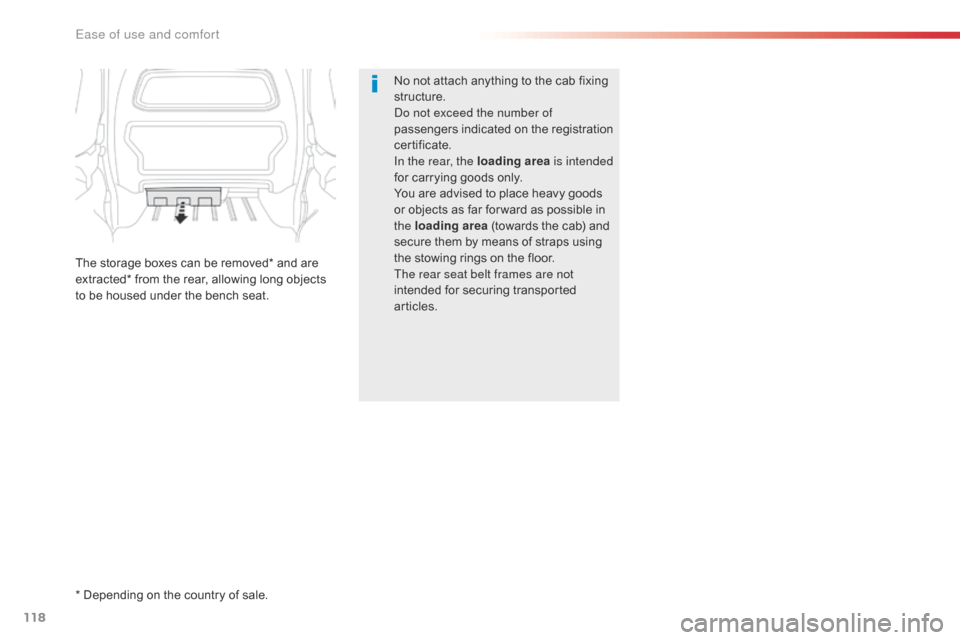
118
Jumpy _en_Chap03_ergonomie-et-confort_ed01-2016
No not attach anything to the cab fixing
structure.
Do not exceed the number of
passengers indicated on the registration
certificate.
In the rear, the loading area is intended
for carrying goods only.
You are advised to place heavy goods
or objects as far for ward as possible in
the loading area (towards the cab) and
secure them by means of straps using
the stowing rings on the floor.
The rear seat belt frames are not
intended for securing transported
articles.
The storage boxes can be removed* and are
extracted* from the rear, allowing long objects
to be housed under the bench seat.
* Depending on the country of sale.
Ease of use and comfort
Page 126 of 595
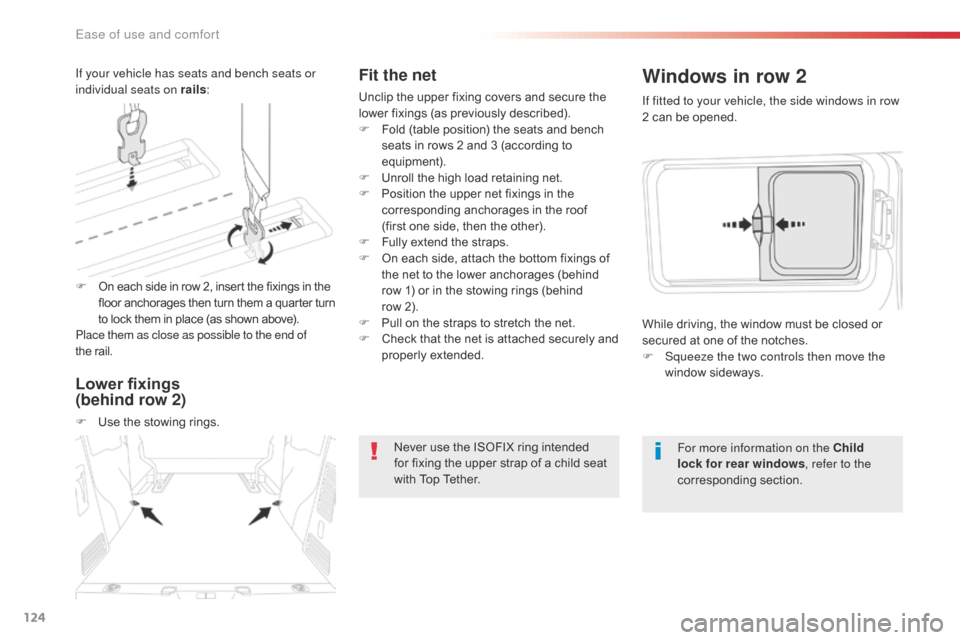
124
Jumpy _en_Chap03_ergonomie-et-confort_ed01-2016
Fit the net
Unclip the upper fixing covers and secure the
lower fixings (as previously described).
F
F
old (table position) the seats and bench
seats in rows 2 and 3 (according to
equipment).
F
U
nroll the high load retaining net.
F
P
osition the upper net fixings in the
corresponding anchorages in the roof
(first one side, then the other).
F
F
ully extend the straps.
F
O
n each side, attach the bottom fixings of
the net to the lower anchorages (behind
row 1) or in the stowing rings (behind
row
2).
F
P
ull on the straps to stretch the net.
F
C
heck that the net is attached securely and
properly extended.
Never use the ISOFIX ring intended
for fixing the upper strap of a child seat
with Top Tether. If fitted to your vehicle, the side windows in row
2 can be opened.
Windows in row 2
For more information on the Child
lock for rear windows
, refer to the
corresponding section.
While driving, the window must be closed or
secured at one of the notches.
F
S
queeze the two controls then move the
window sideways.
F
O
n each side in row 2, insert the fixings in the
floor anchorages then turn them a quar ter turn
to lock them in place (as shown above).
Place them as close as possible to the end of
the
rail.
If your vehicle has seats and bench seats or
individual seats on rails
:
Lower fixings
(behind row 2)
F Use the stowing rings.
Ease of use and comfort
Page 137 of 595

135
Jumpy _en_Chap03_ergonomie-et-confort_ed01-2016
In order for these systems to be fully effective, follow the operation and maintenance
guidelines below:
F
T
o obtain an even air distribution, take care not to obstruct the exterior air intake grilles
located at the base of the windscreen, the nozzles, the vents and the air outlets, as well
as the air extractor located at the rear.
F
D
o not cover the sunshine sensor, located at the top of the windscreen; this is used for
regulation of the air conditioning system.
F
O
perate the air conditioning system for at least 5 to 10 minutes, once or twice a month
to keep it in per fect working order.
F
E
nsure that the passenger compartment filter is in good condition and have the filter
elements replaced regularly.
W
e recommend the use of a combined passenger compartment filter. Thanks to its
special active additive, it contributes to the purification of the air breathed by the
occupants and the cleanliness of the passenger compartment (reduction of allergic
symptoms, bad odours and greasy deposits).
F
T
o ensure correct operation of the air conditioning system, you are also advised to have
it checked regularly as recommended in the maintenance and warranty guide.
F
I
f the system does not produce cold air, switch it off and contact a CITROËN dealer or a
qualified workshop.
Recommendations for heating, ventilation and air conditioning
If after an extended stop in sunshine,
the interior temperature is very high, first
ventilate the passenger compartment for
a few moments.
Put the air flow control at a setting high
enough to quickly change the air in the
passenger compartment.
The air conditioning system does not
contain chlorine and does not present
any danger to the ozone layer.
The condensation created by the air
conditioning results in a discharge
of water under the vehicle which is
per fectly normal.
When towing the maximum load on a steep gradient in high temperatures, switching off the
air conditioning increases the available engine power and so improves the towing ability.
Stop & Start
The heating and air conditioning
systems only work when the engine is
running.
To maintain a comfortable temperature
in the passenger compartment, you can
temporarily deactivate the Stop & Start
system.
For more information on Stop & Star t ,
refer to the corresponding section.
Air vents
To close a vent, move the control
towards the outside of the vehicle. Slight
resistance may be felt.
3
Ease of use and comfort
Page 162 of 595
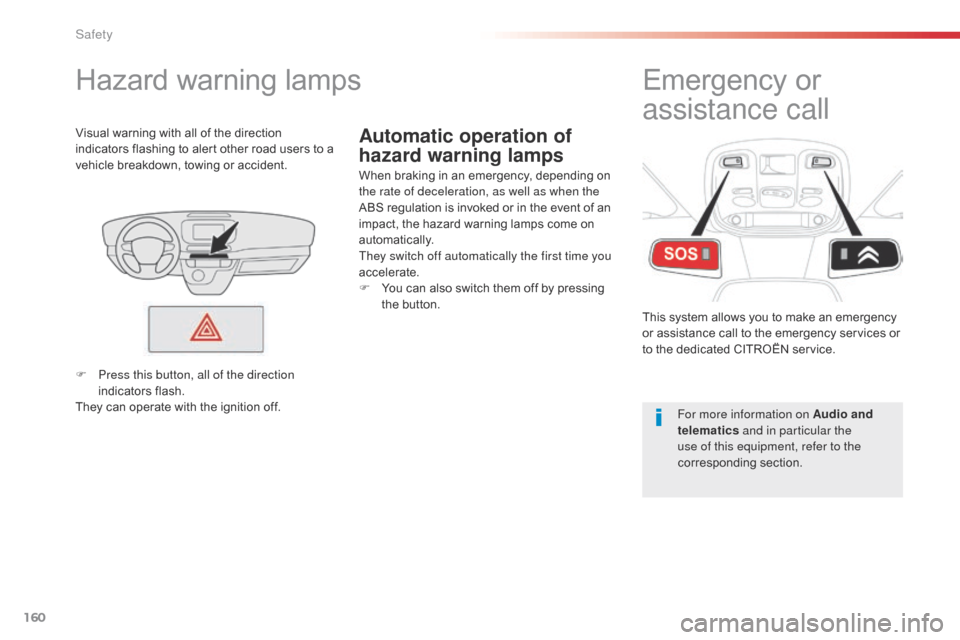
160
Jumpy _en_Chap05_securite_ed01-2016
Automatic operation of
hazard warning lamps
Hazard warning lamps
When braking in an emergency, depending on
the rate of deceleration, as well as when the
ABS regulation is invoked or in the event of an
impact, the hazard warning lamps come on
automatically.
They switch off automatically the first time you
accelerate.
F
Y
ou can also switch them off by pressing
the button.
Visual warning with all of the direction
indicators flashing to alert other road users to a
vehicle breakdown, towing or accident.
Emergency or
assistance call
This system allows you to make an emergency
or assistance call to the emergency services or
to the dedicated CITROËN service.
For more information on Audio and
telematics and in particular the
use of this equipment, refer to the
corresponding section.
F
P
ress this button, all of the direction
indicators flash.
They can operate with the ignition off.
Safety
Page 200 of 595
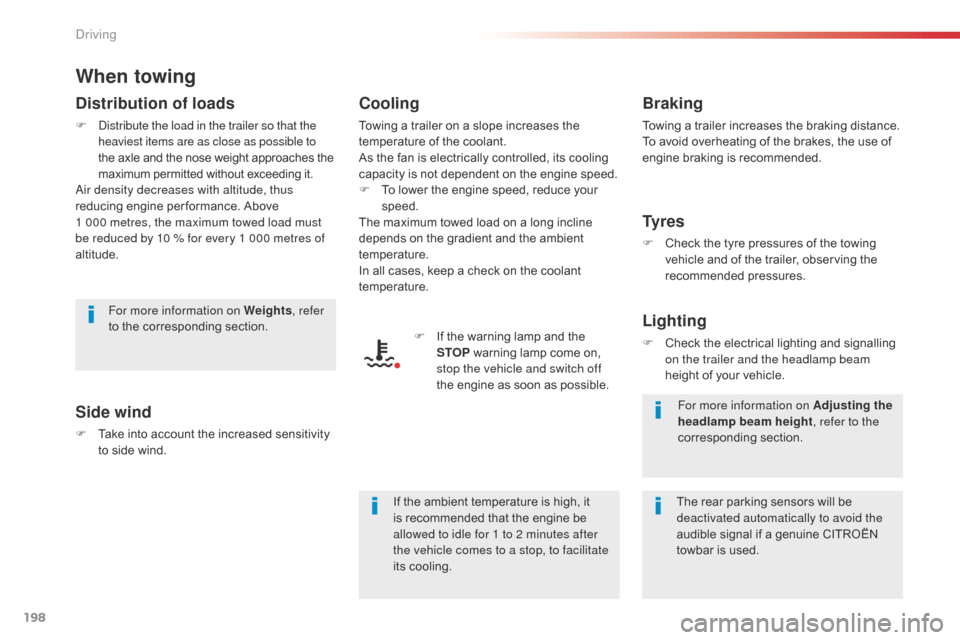
198
Jumpy _en_Chap06_conduite_ed01-2016
When towing
Distribution of loads
F Distribute the load in the trailer so that the heaviest items are as close as possible to
the axle and the nose weight approaches the
maximum permitted without exceeding it.
Air density decreases with altitude, thus
reducing engine per formance. Above
1
000 metres, the maximum towed load must
be reduced by 10
% for every 1 000 metres of
altitude.
Side wind
F Take into account the increased sensitivity to side wind.
Cooling
Towing a trailer on a slope increases the
temperature of the coolant.
As the fan is electrically controlled, its cooling
capacity is not dependent on the engine speed.
F
T
o lower the engine speed, reduce your
speed.
The maximum towed load on a long incline
depends on the gradient and the ambient
temperature.
In all cases, keep a check on the coolant
temperature.
F
I
f the warning lamp and the
STOP warning lamp come on,
stop the vehicle and switch off
the engine as soon as possible.
Braking
Towing a trailer increases the braking distance.
To avoid overheating of the brakes, the use of
engine braking is recommended.
Ty r e s
F Check the tyre pressures of the towing vehicle and of the trailer, observing the
recommended pressures.
Lighting
F Check the electrical lighting and signalling on the trailer and the headlamp beam
height of your vehicle.
For more information on Weights
, refer
to the corresponding section.
The rear parking sensors will be
deactivated automatically to avoid the
audible signal if a genuine CITROËN
towbar is used.
If the ambient temperature is high, it
is recommended that the engine be
allowed to idle for 1 to 2 minutes after
the vehicle comes to a stop, to facilitate
its cooling. For more information on Adjusting the
headlamp beam height
, refer to the
corresponding section.
Driving
Page 237 of 595
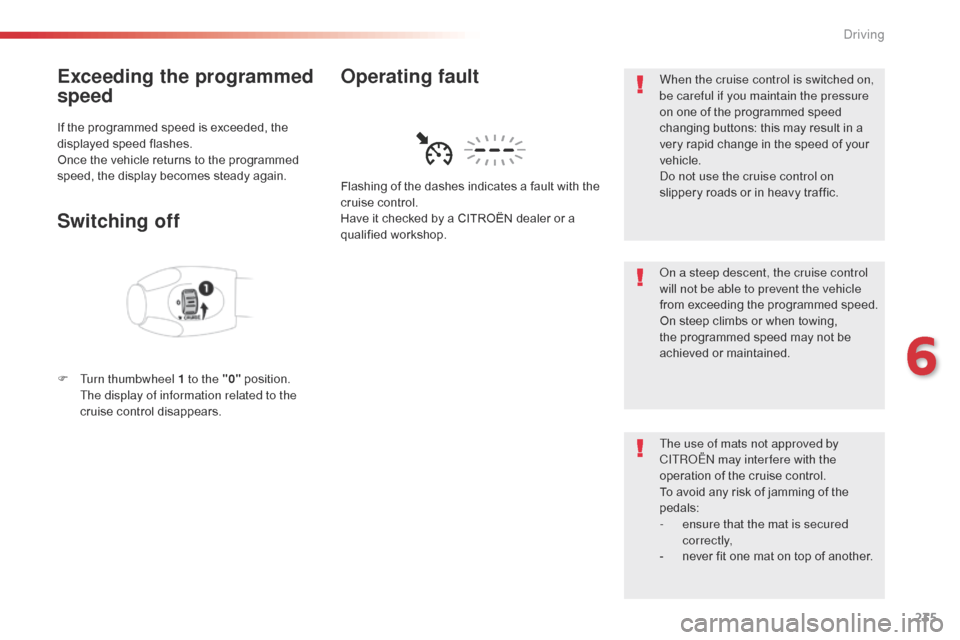
235
Jumpy _en_Chap06_conduite_ed01-2016
Exceeding the programmed
speed
If the programmed speed is exceeded, the
displayed speed flashes.
Once the vehicle returns to the programmed
speed, the display becomes steady again.
Switching off
F Turn thumbwheel 1 to the "0" position. T
he display of information related to the
cruise control disappears. Flashing of the dashes indicates a fault with the
cruise control.
Have it checked by a CITROËN dealer or a
qualified workshop.
Operating faultWhen the cruise control is switched on,
be careful if you maintain the pressure
on one of the programmed speed
changing buttons: this may result in a
very rapid change in the speed of your
vehicle.
Do not use the cruise control on
slippery roads or in heavy traffic.
On a steep descent, the cruise control
will not be able to prevent the vehicle
from exceeding the programmed speed.
On steep climbs or when towing,
the programmed speed may not be
achieved or maintained.
The use of mats not approved by
CITROËN may inter fere with the
operation of the cruise control.
To avoid any risk of jamming of the
pedals:
-
e
nsure that the mat is secured
c o r r e c t l y,
-
n
ever fit one mat on top of another.
6
Driving
Page 244 of 595

242
Jumpy _en_Chap06_conduite_ed01-2016
In the event of a fault with the dynamic cruise
control, you are alerted by an audible signal
and display of the message message "Driving
aid functions fault".
Have the system checked by a CITROËN
dealer or a qualified workshop.
Operating faultThe dynamic cruise control operates
by day and at night, in fog or moderate
rainfall.When the cruise control is working, take
care if making a maintained press on
one of the cruise control programmed
speed modification buttons: this can
lead to a very quick change in the
speed of your vehicle.
Do not use the dynamic cruise control
on slippery sur faces or in heavy traffic.
When descending a steep hill, the
cruise control may not be able to
prevent the vehicle from exceeding the
programmed speed.
When ascending a steep hill or when
towing, it might not be possible to
achieve or maintain the programmed
speed.
The use of mats not approved by
CITROËN may inter fere with the
operation of the dynamic cruise control.
To avoid any risk of jamming the pedals:
-
e
nsure that mats are secured
c o r r e c t l y,
-
n
ever fit one mat on top of another.
It is recommended that you always keep
your feet close to the pedals.
If the difference between the
programmed speed setting and the
speed of the vehicle in front is too
great, the speed cannot be adjusted:
the cruise control is automatically
deactivated. The system does not act on the braking
system, but works only with engine
braking.
The regulation range is limited: there
will no longer be any adjustment of
speed if the difference between the
programmed speed setting and the
speed of the vehicle in front becomes
too high.
The dynamic cruise control cannot
in any circumstances replace the
observation of speed limits, nor the
need for the vigilance on the part of the
driver.
Driving